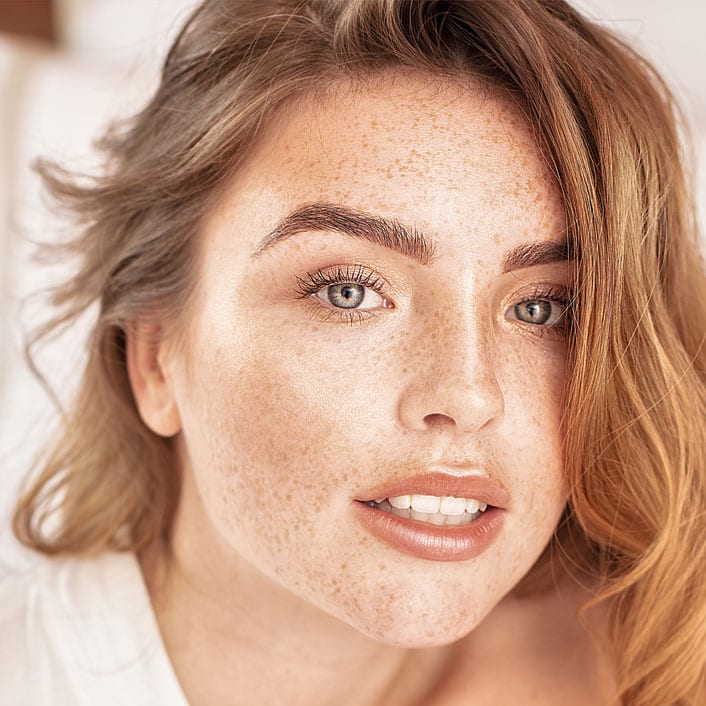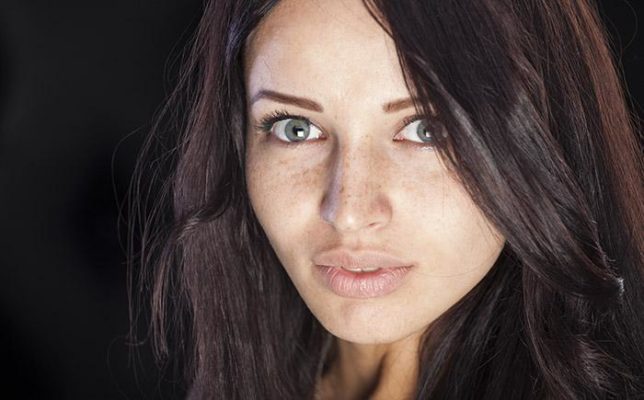A Guide on Skin Care and Makeup for Freckles
Freckles are a common condition that can accompany any skin type or tone. Flat brown, yellow, red or black circular spots may appear on the face, arms, shoulders or other areas frequently exposed to sunlight. Find out more about the characteristics and causes of freckles as well as solutions involving freckles makeup or skincare treatments that reduce the appearance of existing freckles and limit the formation of new freckles.

Freckles result from the overproduction of melanin granules or melanosomes by melanocytes or melanin-producing cells, not an increase in the number of these cells. Melanosomes change the color of outer skin cells or keratinocytes. Freckles can appear on all types and tones of skin, but are most common on fair skin.
Skin tones one and two out of the six Fitzpatrick skin types are most likely to develop freckles. While Northern Europeans are more likely to have freckles, people of all ethnicities can experience this skin condition. The type of melanin in skin may determine the likelihood that freckles will form.
Pheomelanin is present in individuals with lighter skin and red or blonde hair who do not tan well. These individuals may be predisposed to develop freckles based on genetic factors and sun exposure. Eumelanin is found in individuals with darker skin and hair that tans easily and has more built-in protection from UV radiation. Regardless of the type of melanin, all individuals should wear sunscreen to prevent skin damage. Freckles may fade over the winter or with the use of daily sun protection and look less obvious under makeup for freckles.
Other spots may form on skin that are not freckles. Ephelides are different from lentigines, which are commonly referred to as sun spots, age spots or liver spots. Lentigo simplex or solar lentigo are caused by a concentration of melanin-producing cells and pigment. These spots tend to be larger and darker than freckles and do not fade in winter or with reduced UV exposure. Lentigines tend to appear on the back of hands over time due to sun exposure, not just age. These spots may be more likely to form on darker skin tones or skin prone to developing freckles after hormonal treatments or sun damage.
Moles also differ from freckles. A brown or black flat or slightly elevated bump may be caused by benign melanocytes. Older people may also experience raised sebborheic keratoses lesions. None of these conditions resemble freckles, which are flat and tend to be smaller in size. It may be possible to use some of the same treatments for skin discoloration or freckles makeup on sun spots or moles. Have any spots on skin with an unusual appearance checked by a dermatologist.

While freckles are most common in individuals with blonde or red hair, light-colored eyes and fair skin, people from any part of the world can have freckles. Genetic variants associated with freckles tend to be near genes that determine skin, eye and hair color. Other genes associated with freckles include IRF4, ASIP, TYR and BNC2. The genetic origins of freckles have also been indicated in research on identical twin siblings, who tend to have a similar total number of freckles.
If you are disposed to develop freckles, sun exposure is the most important factor for determining whether freckles will form and the location, quantity and color of spots. Exposure to direct sunlight without sun protection or the use of tanning beds can cause freckles to form. As UV rays are absorbed by skin, UVB rays activate melanocytes or melanin-producing cells, which increase production. Freckles tend to become darker and more visible with more UV light exposure. Reducing the appearance of these spots is possible with sun protection and freckles makeup or skincare treatments.

In addition to topical sun protection, you can avoid more sun exposure with protective clothing. Look for clothing with an Ultraviolet Protection Factor. Coverings with a UPF 50 rating block up to 98% of UVA and UVB rays. Wearing a wide-brimmed hat can be ideal for protecting your face for the sun. If you are prone to develop freckles on your arms, shoulders or other areas, you may also want to wear breathable and lightweight protective clothing.
If you want to avoid developing freckles, it is a good idea to limit your exposure to intense sunlight. Try to limit direct exposure during the peak hours of sunlight between 10 AM and 4 PM. If you must spend a prolonged period of time in the sun, wear sunscreen, a hat and protective clothing.
Children may start to develop freckles caused by sun exposure as early as age two. Most sun damage occurs before age 18. If your skin tends to experience sunburn, you should try to limit sun damage that can result in freckles and other discoloration as well as causing premature aging and an increased skin cancer risk.
The best solutions for freckles that don’t involve skincare treatments are makeup for freckles. You may be able to even out your skin tone by using a tinted moisturizer between the color of your skin and your freckles. Applying a slightly darker shade, particularly during the summer, makes it easier to blend freckles into the surrounding skin.
Some people prefer the lightweight coverage achieved with a mineral powder foundation. Sheer products can promote a more even appearance. Trying to hide freckles may have less flattering results than evening out your skin tone and accentuating features.
If you prefer a more full-coverage approach to freckles makeup, apply liquid foundation in a matching or slightly darker shade, concealer that has a yellow or orange tone and finishing powder. You may also find it helpful to use bronzer to even out the appearance of darker spots and the shade of surrounding skin.
Some makeup artists recommend starting with foundation and applying concealer and powder afterward. Dab concealer on spots with your fingertip or a concealer brush. Sweeping a hand or brush over the spot will diminish coverage. Blend concealer around freckles and lock in coverage with translucent powder. Matte formulas tend to be ideal for more complete coverage.

Several types of lasers are used to deliver focused pulses of intense light to eliminate melanin containing cells in the epidermis. Q-switched Alexandrite and Q-switched Nd YAG lasers are most effective for treating freckles. A Q-switched Nd YAG laser lightened more than 50% of freckles on the skin of 62% of the participants in a 2015 study. Use of a Q-switched Alexandrite laser may lead to less post-inflammatory hyperpigmentation. Some side effects of light-based skin treatments may include crusting, itching, peeling, infection, redness or swelling. Photofacials and IPL treatments are less effective than laser treatments.
Cryosurgery is rarely recommended for treating freckles. This treatment involves lightly freezing skin cells with liquid nitrogen and can be done in a doctor’s office without anesthesia. While this process has a very short recovery time, the side effects may make it less appealing to individuals trying to banish freckles. Cryosurgical treatments may cause bleeding, blistering or scarring and even result in hyperpigmentation
Many over-the-counter and prescription fading creams contain hydroquinone. Concentrations up to 2% can be found in consumer-grade products, while strengths from 2% up to 4% are available from a dermatologist. This depigmenting agent is thought to work by suppressing the production of melanin and lightening dark spots on skin. Months of treatment may be necessary to fade dark freckles. It is necessary to wear sun protection while using hydroquinone, which makes skin more sensitive to photodamage. These products may lighten spots to the point where freckles makeup provides full coverage.
Hydroquinone is not always preferable for treating skin discoloration. This product can have side effects such as dryness, inflammation and even further discoloration. The National Toxicology Program is researching links between hydroquinone use and cancer, but these treatments will remain on the market until conclusive results are available. Kojic acid and alpha arbutin are popular ingredients for combining with hydroquinone or using separately to lighten skin and keep new freckles from becoming visible.
Retinoids and chemical peels promote skin cell turnover. Tretinoin, tazarotene and adapalene can improve the appearance of skin with sun damage and reduce the appearance of freckles. Retinoids may also impart photoprotection to skin by absorbing UVB radiation that could cause further damage. It is important to wear sunscreen for the duration of any chemical treatment.
Chemical peels exfoliate the surface of skin and can penetrate to the middle layers to reduce discoloration. Alpha or beta hydroxy acids are often used, as are Jessner’s, modified Jessner’s, resorcinol or trichloroacetic acid peels. It may take up to two weeks for skin to heal after a chemical peel, during which time side effects may include crusting, irritation, peeling, redness or swelling. After-care for this procedure involves daily soaks, applications of topical ointment, taking a prescription antiviral treatment for up to two weeks and sun avoidance.
All of these treatments are more effective than any home remedy for freckles. Many natural treatments involve applying acidic substances to skin that could cause irritation and are not proven to work. The malic acid found in apple cider vinegar and Vitamin C in lemon are two common suggestions. Other treatments such as aloe vera, banana peels, eucalyptus oil, honey, pomelo essential oil, shea butter and turmeric are sometimes suggested for topical use to lighten skin discoloration.
No freckle treatment can prevent discoloration from returning after sun exposure. It is important to wear sunscreen, freckles makeup with SPF or protective clothing. For this reason, many people with freckles either choose to embrace this benign and unique skin condition or wear makeup for freckles to create the appearance of a more even skin tone.

Carefully monitor the appearance of your skin during freckle treatments. Procedures administered by a dermatologist and over-the-counter skin lightening products can both cause irritation. Take care to avoid making a reaction worse and soothe skin until it heals. Freckles tend to remain on skin over time and increase in number or darkness with sun exposure. These spots may become lighter during the winter or with daily use of sun protection. Some people with freckled skin also report that spots become lighter as they age.
Whether you embrace your freckles or try to lighten or remove these small spots of discoloration, there are many effective skin care treatments and freckles makeup products. People with freckles should always wear sunscreen to limit sun damage.
5 Tips for Freckles In Summer
Freckles are on trend in 2021. A quick scroll down social media [Read More...]
Reasons to Love Vitamin C
We've all heard time and time again that we need to eat [Read More...]
We Tested How to Draw Fake Freckles and This Is What We Learned
One of the latest beauty trends that is making its presence known [Read More...]




